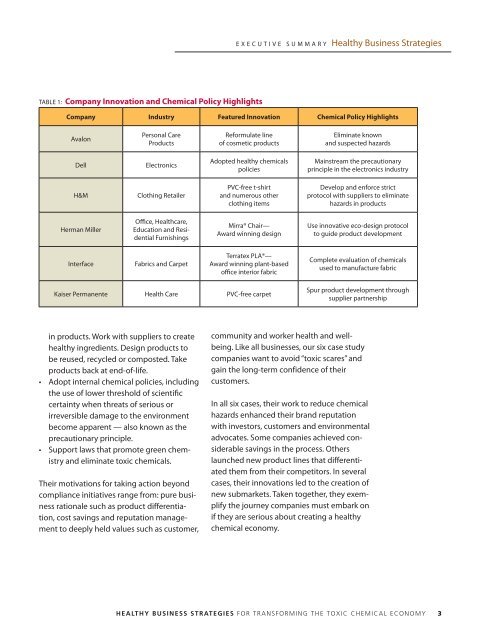Healthy Business Strategies - Clean Production Action
Healthy Business Strategies - Clean Production Action
Healthy Business Strategies - Clean Production Action
You also want an ePaper? Increase the reach of your titles
YUMPU automatically turns print PDFs into web optimized ePapers that Google loves.
TABLE 1: company Innovation and chemical Policy Highlights<br />
company Industry Featured Innovation chemical Policy Highlights<br />
Avalon<br />
Personal Care<br />
Products<br />
Dell Electronics<br />
H&M Clothing Retailer<br />
Herman Miller<br />
Office, Healthcare,<br />
Education and Residential<br />
Furnishings<br />
Interface Fabrics and Carpet<br />
Reformulate line<br />
of cosmetic products<br />
Adopted healthy chemicals<br />
policies<br />
PvC-free t-shirt<br />
and numerous other<br />
clothing items<br />
Mirra® Chair—<br />
Award winning design<br />
Terratex PLA®—<br />
Award winning plant-based<br />
office interior fabric<br />
Kaiser Permanente Health Care PvC-free carpet<br />
in products. Work with suppliers to create<br />
healthy ingredients. Design products to<br />
be reused, recycled or composted. Take<br />
products back at end-of-life.<br />
• Adopt internal chemical policies, including<br />
the use of lower threshold of scientific<br />
certainty when threats of serious or<br />
irreversible damage to the environment<br />
become apparent — also known as the<br />
precautionary principle.<br />
• Support laws that promote green chemistry<br />
and eliminate toxic chemicals.<br />
Their motivations for taking action beyond<br />
compliance initiatives range from: pure business<br />
rationale such as product differentiation,<br />
cost savings and reputation management<br />
to deeply held values such as customer,<br />
E x E C u T I v E S u M M A R y <strong>Healthy</strong> <strong>Business</strong> <strong>Strategies</strong><br />
Eliminate known<br />
and suspected hazards<br />
Mainstream the precautionary<br />
principle in the electronics industry<br />
Develop and enforce strict<br />
protocol with suppliers to eliminate<br />
hazards in products<br />
use innovative eco-design protocol<br />
to guide product development<br />
Complete evaluation of chemicals<br />
used to manufacture fabric<br />
Spur product development through<br />
supplier partnership<br />
community and worker health and wellbeing.<br />
Like all businesses, our six case study<br />
companies want to avoid “toxic scares” and<br />
gain the long-term confidence of their<br />
customers.<br />
In all six cases, their work to reduce chemical<br />
hazards enhanced their brand reputation<br />
with investors, customers and environmental<br />
advocates. Some companies achieved considerable<br />
savings in the process. Others<br />
launched new product lines that differentiated<br />
them from their competitors. In several<br />
cases, their innovations led to the creation of<br />
new submarkets. Taken together, they exemplify<br />
the journey companies must embark on<br />
if they are serious about creating a healthy<br />
chemical economy.<br />
healthy business strategies for transforming the toxic chemical economy


